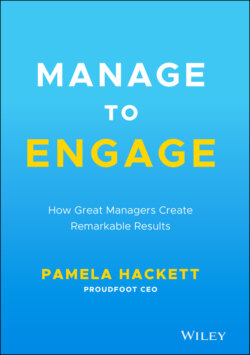Читать книгу Manage to Engage - Pamela Hackett - Страница 34
CHAPTER 1 People Matter: We Need a Healthier Way of Working
ОглавлениеHaving an engaging environment goes far beyond the workplace itself. When people feel a connection to their jobs, they are more willing to embrace bigger visions, ones that require them to take a leap of faith. They feel a part of something bigger than themselves. They engage in shaping the future. It's the great leader that makes that happen.
—Lorena Schoenfeld, Proudfoot chief of staff and executive director
Prior to COVID-19, and if you look closely at the cover page of Gallup's State of The Global Workplace report1 published in 2017, in tiny print it says 85 percent of employees worldwide are not engaged or are actively disengaged in their job. With that bleak statistic, it's surprising that companies got any work done at all. Although increasing numbers of companies realize that what's good for people is good for business, something was clearly still amiss. During my 30 years of management consulting, I have pored over study after global study looking for what is wrong – what businesses across the planet are doing (or not) to create and foster a happy, satisfied, and high-performing workforce. Sadly, the picture that emerged was anything but heartwarming: rather, we appeared to have been living through (and barely surviving) a continued Ice Age – categorized by disconnects, disenfranchisement, and disgruntlement; an epidemic of underengagement and ineffective management solutions. For the billions spent on engagement efforts, organizations had failed to engage with their people. As a result, people were not exactly chipper about showing up at work each day. Many had mentally checked out. We had an army of the “quit but stayed.”
In early December 2019, when the pandemic was still nothing but an isolated bug, Klaus Schwab, founder and executive chairman of the World Economic Forum, was busy rallying his Davos cohorts into backing the Davos Manifesto 2020: The Universal Purpose of a Company in the Fourth Industrial Revolution.2 He acknowledged that we needed a more all-encompassing declaration that included all stakeholders, not just shareholders, and the planet. This followed the Business Roundtable, announcing a few months earlier the release of a new Statement on the Purpose of a Corporation. It was signed by 181 CEOs who “commit to lead their companies for the benefit of all stakeholders – customers, employees, suppliers, communities and shareholders.” Something was abuzz. “The American dream is alive, but fraying,” said Jamie Dimon, chairman and CEO of JPMorgan Chase & Co. and chairman of Business Roundtable. The Roundtables website continued with the rest of his quote: “Major employers are investing in their workers and communities because they know it is the only way to be successful over the long term. These modernized principles reflect the business community's unwavering commitment to continue to push for an economy that serves all Americans,” or the world, you could continue. This was being espoused from the highest echelon of corporations.
By mid-2020 when the pandemic had taken hold of the world economy and impacted the health of some 16 million people, Gallup,3 the analytics and advisory firm, reported employee engagement at an all-time high: some 40 percent of employees surveyed, reported to be engaged and 13 percent were said to be actively disengaged. The headlines espoused the unusual jump in engagement. Unusual scores for unusual times. There was just one problem. A whopping 60 percent were still underengaged. And the numbers trended down again as the pandemic continued.
